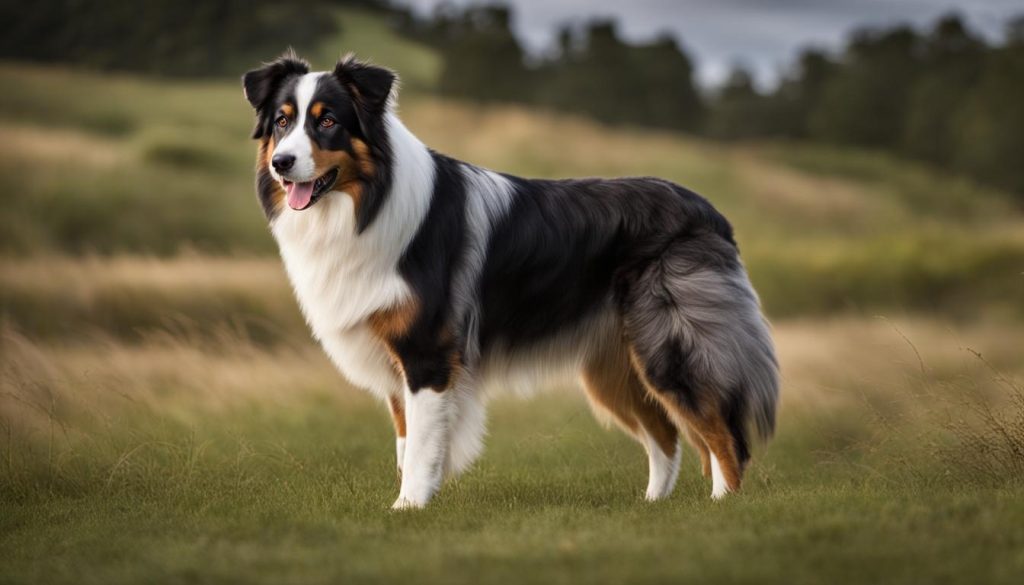Australian Shepherds, also known as Aussies, are medium-sized working dogs that are highly sociable, energetic, and intelligent. They make excellent family dogs and are always eager to be a part of a loving family. They have a history of herding livestock and have gained recognition for their ability to work alongside farmers. Aussies are very trainable, responsive to positive reinforcement, and have a strong instinctual desire to protect their family. They are generally placid and easy-going, making them ideal companions for both children and adults.
Australian Shepherds can grow to be around 46-58 centimeters tall and weigh between 16 to 32 kilograms. While they have a relatively healthy breed, they may be prone to vision problems, hip dysplasia, and certain genetic conditions like progressive retinal atrophy and deafness in double merle Australian Shepherds. Aussies need ample exercise, outdoor spaces to run and play, and daily mental stimulation. They are moderate shedders and require regular grooming to prevent matting in their fur.
Australian Shepherds are generally good with children and get along well with other pets, but it is always important to supervise interactions and provide proper training and socialization. The average lifespan of Australian Shepherds is between 13 and 15 years.
Key Takeaways:
- Australian Shepherds are highly sociable, energetic, and intelligent.
- They have a strong instinctual desire to protect their family.
- Aussies are generally placid and easy-going, making them ideal companions for both children and adults.
- They may be prone to vision problems, hip dysplasia, and certain genetic conditions.
- Aussies require ample exercise, outdoor spaces to run and play, and daily mental stimulation.
History of the Australian Shepherd

The Australian Shepherd breed has an interesting history, despite its misleading name. Contrary to popular belief, Australian Shepherds do not originate from Australia. Instead, they have English roots and share similarities with English Border Collies and sheepdogs. The name “Australian Shepherd” may have come about because observers saw these dogs working on Australian farms, leading to the misconception of their origin. In reality, the breed was officially recognized in the early 20th century and gained popularity due to its exceptional herding abilities. Australian Shepherds are now renowned worldwide for their skills in working alongside farmers and herding sheep and other livestock.
Key Moments in Australian Shepherd History:
- Originated from English roots, not Australia
- Formally recognized as a breed in the early 20th century
- Gained popularity due to exceptional herding abilities
- Renowned worldwide for their skills in working with farmers
Personality of Australian Shepherds

Australian Shepherds are known for their exceptional personality traits, making them a popular choice for families. These intelligent and highly trainable dogs have a natural affinity for their human companions. They are loyal, affectionate, and eager to please, making them ideal family pets.
One of the standout traits of Australian Shepherds is their energy and enthusiasm. They have a zest for life and a love for outdoor activities. Whether it’s playing fetch in the backyard, going for long walks, or participating in agility training, these dogs thrive when they have plenty of physical and mental stimulation.
Despite their active nature, Australian Shepherds have a gentle and friendly disposition. They are typically good with children and get along well with other pets when properly socialized. Their herding instincts may come into play, as they may try to gather and watch over their family members, including younger children. However, it is important to supervise interactions to ensure everyone’s safety.
Intelligence and Trainability
Australian Shepherds are highly intelligent dogs, ranking among the most trainable breeds. They are quick learners and excel in obedience training. With consistent positive reinforcement and reward-based methods, these dogs can master various commands and tricks.
Their intelligence and willingness to please make them suitable for many activities beyond basic obedience. They often excel in agility, flyball, and even search and rescue work. Mental stimulation is just as important as physical exercise for Australian Shepherds, as it keeps their minds sharp and prevents boredom-induced destructive behaviors.
Vigilance and Protective Instincts
Australian Shepherds have a natural instinct to protect their loved ones. While they are not typically aggressive, they will bark to alert their family of any potential threats or intruders. This vigilance and protective nature make them excellent watchdogs.
It is important to provide early socialization and proper training to ensure that their protective instincts are directed in a positive and controlled manner. Teaching them to differentiate between real threats and everyday situations will help them become well-rounded and balanced family companions.
| Traits | Description |
|---|---|
| Intelligent | Australian Shepherds are highly intelligent and quick learners. |
| Energetic | These dogs have a high energy level and require plenty of exercise. |
| Loyal | Australian Shepherds form strong bonds with their families and are fiercely loyal. |
| Friendly | They have a friendly and sociable nature, getting along well with children and other pets when properly socialized. |
| Protective | Australian Shepherds exhibit a protective instinct and will bark to alert their family of potential threats. |
Size and Health of Australian Shepherds

Australian Shepherds are classified as medium-sized dogs, with a height ranging from 46 to 58 centimeters and a weight between 16 to 32 kilograms. They have a sturdy build and a well-proportioned body, making them agile and athletic.
While Australian Shepherds are generally a healthy breed, they may be prone to certain health conditions. Some common health problems that can affect Australian Shepherds include vision problems, hip dysplasia, and certain genetic conditions.
Vision Problems:
Australian Shepherds can be susceptible to vision problems such as progressive retinal atrophy (PRA) and cataracts. PRA is a degenerative eye disease that can lead to vision loss and blindness. Regular eye check-ups and screening can help detect and manage these conditions in Australian Shepherds.
Hip Dysplasia:
Hip dysplasia is a hereditary condition where the hip joint doesn’t develop properly. It can lead to lameness, arthritis, and pain in affected dogs. Responsible breeders often screen their Australian Shepherds for hip dysplasia to reduce the risk of passing on this condition to their offspring.
Genetic Conditions:
Australian Shepherds that carry the merle gene, known as double merles, are more likely to experience vision and hearing problems. Double merle Australian Shepherds have a higher risk of being born deaf or having impaired hearing. It is important to obtain puppies from reputable breeders who take measures to prevent double merle breeding and prioritize the health of their dogs.
Proper nutrition, regular exercise, and routine veterinary check-ups are essential for maintaining the overall health and well-being of Australian Shepherds. It is advisable to consult with a veterinarian for guidance on specific health concerns and to ensure the long and happy life of your Australian Shepherd.
Living with an Australian Shepherd

Living with an Australian Shepherd is an exciting and rewarding experience, but it requires a lifestyle that suits their needs. These energetic and active dogs thrive in homes with access to outdoor spaces where they can run, play, and exercise. Apartment living may not be ideal for Australian Shepherds due to their need for ample physical activity.
Australian Shepherds are known for their high energy levels and require a significant amount of exercise on a daily basis. A combination of walks, runs, and play sessions is necessary to keep them physically and mentally stimulated. Regular exercise not only helps prevent destructive behaviors but also contributes to their overall health and well-being.
When it comes to grooming, Australian Shepherds have a medium-length double coat that requires regular brushing to prevent matting and keep their fur healthy. They are moderate shedders, so frequent brushing can help manage shedding and keep your home clean. Additionally, regular bathing and nail trimming should be part of their grooming routine.
Overall, living with an Australian Shepherd requires an active and dedicated lifestyle. Providing them with plenty of exercise, mental stimulation, and proper grooming will ensure they are happy, healthy, and well-adjusted family members.
Exercise Needs of Australian Shepherds
Australian Shepherds are a highly active breed that needs regular exercise to prevent boredom and destructive behaviors. They thrive in homes with large, securely fenced yards where they can run and play freely. Daily walks, hikes, and off-leash playtime are essential to fulfill their exercise needs. Engaging them in activities like agility, herding, or obedience training can also provide mental stimulation alongside physical exertion.
Grooming Australian Shepherds
Grooming is an important part of caring for an Australian Shepherd. Their thick double coat requires regular brushing to keep it in good condition and prevent matting. Brushing should be done at least once a week, but more frequent brushing may be required during shedding seasons. Bathing should be done as needed, using a dog-specific shampoo to avoid skin irritation. Regularly checking their ears, teeth, and nails is also important to ensure their overall health and well-being.
| Exercise Needs | Grooming |
|---|---|
| Australian Shepherds require daily exercise, including walks, runs, and playtime. | They have a medium-length double coat that requires regular brushing to prevent matting. |
| Engaging them in activities like agility and herding can provide mental stimulation. | Bathing should be done as needed, using a dog-specific shampoo. |
| Securely fenced yards are ideal for Australian Shepherds to run and play freely. | Regularly checking their ears, teeth, and nails is important for their overall health. |
Feeding and Diet for Australian Shepherds

A proper diet is essential for the health and well-being of Australian Shepherds. These active and energetic dogs have high energy needs and require a nutritionally balanced diet to support their active lifestyle. Here are some important factors to consider when it comes to feeding and diet for Australian Shepherds.
Nutritional Needs
Australian Shepherds require a diet that is rich in proteins, healthy fats, and essential nutrients. Proteins are important for muscle development and repair, while fats provide energy and support healthy skin and coat. Look for dog food that lists high-quality protein sources such as chicken, beef, or lamb as the main ingredient. Avoid dog foods that contain excessive amounts of fillers or artificial additives.
In addition to proteins and fats, Australian Shepherds also need a variety of vitamins and minerals to maintain optimal health. These include vitamins A, B, C, D, and E, as well as minerals like calcium, phosphorus, and zinc. It is best to choose dog food that is specifically formulated for medium-sized, active breeds like Australian Shepherds, as these will often meet their nutritional needs.
Feeding Guidelines
The amount of food and the frequency of feeding will depend on various factors such as the dog’s age, weight, activity level, and metabolism. In general, Australian Shepherds should be fed two meals a day, with portion sizes adjusted based on their individual needs. It is important not to overfeed them, as obesity can lead to various health problems. Consult with your veterinarian to determine the appropriate portion sizes and feeding schedule for your Australian Shepherd.
Special Considerations
While dry dog food is a popular choice for Australian Shepherds, some owners prefer to feed them a combination of dry and wet food. Wet food can provide additional hydration and variety to their diet. It is essential to provide fresh, clean water at all times to keep them properly hydrated.
In addition to their regular diet, Australian Shepherds may benefit from occasional treats or snacks for training purposes or as rewards. However, it is important to choose healthy treats that are low in calories and do not contain any harmful ingredients.
| Feeding Guidelines for Australian Shepherds | Puppy (8-12 weeks) | Puppy (3-6 months) | Adult (1-7 years) | Senior (7+ years) |
|---|---|---|---|---|
| Feeding Frequency | 4 meals a day | 3 meals a day | 2 meals a day | 2 meals a day |
| Portion Size | 1/4 – 1/2 cup per meal | 1/2 – 1 cup per meal | 1 – 2 cups per meal | 1 – 2 cups per meal |
| Food Type | Puppy formula or small kibble | Puppy formula or medium kibble | Adult formula or medium kibble | Senior formula or medium kibble |
It is important to monitor your Australian Shepherd’s weight and body condition regularly. Adjust the portion sizes and feeding schedule accordingly if they are gaining or losing weight. Remember to provide plenty of exercise and mental stimulation to keep them happy and healthy.
Australian Shepherd Appearance and Coat Colors

Australian Shepherds are known for their beautiful appearance and unique coat colors. These medium-sized dogs have a shaggy coat that fluffs up around their necks and the back of their legs, giving them an adorable and distinctive look. Their coat comes in a variety of colors, making them even more visually appealing.
The most common coat colors of Australian Shepherds include combinations of blacks, whites, copper reds, and browns. However, what sets them apart is the mesmerizing merle pattern that can be seen on their coat. The merle pattern is characterized by a speckled effect, creating a stunning visual display on their fur.
Additionally, merle Australian Shepherds may exhibit heterochromia, which means they can have two different colored eyes. This unique feature adds to their overall charm and makes them stand out from other dog breeds.
| Coat Color | Description |
|---|---|
| Black Tri | Black coat with white and copper markings |
| Red Tri | Red coat with white and copper markings |
| Blue Merle | Black coat with a blue-gray merle pattern and white markings |
| Red Merle | Red coat with a reddish merle pattern and white markings |
As you can see, Australian Shepherds are not only known for their loving personalities and intelligence but also for their stunning appearance and coat colors. Whether you prefer the classic black tri, the vibrant red tri, or the mesmerizing merle pattern, these dogs are sure to capture your heart and turn heads wherever they go.
Australian Shepherds and Family: Perfect Companions

Australian Shepherds are renowned for their friendly and family-oriented nature. Their sociable, energetic, and intelligent personalities make them excellent companions for both children and pets. These dogs have a natural affinity for families and thrive in a loving and nurturing environment.
When it comes to children, Australian Shepherds are known to be patient, gentle, and protective. Their playful nature and high energy levels make them ideal playmates for kids. Whether it’s a game of fetch in the backyard or a cuddle session on the couch, Australian Shepherds are always ready to engage and provide endless entertainment for children.
As for other pets, Australian Shepherds are generally good with other breeds of dogs and can form strong bonds with them. They often showcase their herding instincts during playtime, exhibiting their natural ability to bring animals together and maintain harmony. However, it’s important to introduce Australian Shepherds to other pets gradually and provide proper training and socialization to ensure a harmonious coexistence.
Australian Shepherds are highly adaptable and versatile dogs who thrive in a family setting. Their loyalty, love, and protective nature make them the perfect four-legged family members, bringing joy, laughter, and endless memories to any household.
When considering Australian Shepherds as a family dog, it’s vital to understand their exercise needs and ensure they receive ample physical activity. These dogs are highly active and require daily exercise to keep them mentally and physically stimulated. Regular walks, play sessions, and outdoor adventures are essential to their overall well-being.
In summary, Australian Shepherds are family-friendly dogs that get along well with children and other pets. Their sociable, energetic, and intelligent nature makes them ideal companions for families seeking a loyal and reliable four-legged friend. With proper care, training, and attention to their exercise needs, Australian Shepherds can bring immense joy, love, and happiness to any family setting.
Wrapping Up: Australian Shepherds as Ideal Family Dogs
After careful consideration of the Australian Shepherd breed, it is evident that they make exceptional family dogs. With their sociable, energetic, and intelligent nature, Aussies are well-suited to be loyal and reliable companions for families. Their history as herding dogs has instilled in them a strong desire to protect their loved ones, while their easy-going temperament allows them to get along well with children and other pets.
While Australian Shepherds have specific exercise and grooming needs, providing a suitable environment with ample outdoor space for them to run and play is essential. Regular exercise, mental stimulation, and proper training will ensure that they remain happy and well-adjusted family pets. Additionally, maintaining their health through regular vet check-ups and a nutritious diet will support their overall well-being.
To summarize, Australian Shepherds are undeniably good family dogs. Their sociability, energy, intelligence, and loyalty make them an ideal choice for those seeking a devoted and loving companion. However, it is important to note that every dog’s temperament is unique, and individual characteristics may vary. By providing the necessary care, attention, and training, Australian Shepherds can thrive as cherished members of the family.
FAQ
Are Australian Shepherds good family dogs?
Yes, Australian Shepherds are excellent family dogs. They are sociable, energetic, and intelligent, making them ideal companions for families.
What is the history of the Australian Shepherd breed?
Despite their name, Australian Shepherds do not originate from Australia. They have English roots and share similarities with English Border Collies and sheepdogs. The name “Australian Shepherd” may have originated from observers who saw these dogs on Australian farms.
What is the personality of Australian Shepherds?
Australian Shepherds are highly sociable and intelligent dogs. They are easy-going, responsive to positive reinforcement, and have a strong instinctual desire to protect their family.
How big are Australian Shepherds and what are their common health conditions?
Australian Shepherds are medium-sized dogs, growing to be around 46-58 centimeters tall and weighing between 16 to 32 kilograms. While they are generally a healthy breed, they may be prone to vision problems, hip dysplasia, and certain genetic conditions like progressive retinal atrophy and deafness in double merle Australian Shepherds.
What is it like to live with an Australian Shepherd?
Living with an Australian Shepherd is best suited for people who have access to outdoor spaces for them to run, play, and exercise. They require ample exercise, mental stimulation, and regular grooming to keep them happy and healthy.
What should I feed my Australian Shepherd?
Australian Shepherds should be fed a diet that is high in nutrients and lower in calories to keep them healthy. Look for dog food that lists proteins such as chicken, beef, or lamb, along with healthy fats and nutrients.
What do Australian Shepherds look like?
Australian Shepherds have a beautiful, shiny coat that comes in various colors, including combinations of blacks, whites, copper reds, and browns. They have a similar appearance to Border Collies and English Shepherds, with a shaggy coat and a naturally short tail.
Are Australian Shepherds good with children and other pets?
Yes, Australian Shepherds are generally good with children and get along well with other pets. However, it is important to supervise interactions and provide proper training and socialization.
Are Australian Shepherds good family dogs?
Yes, Australian Shepherds are great family dogs. Their sociable, energetic, and intelligent nature makes them ideal companions for families. They are loyal and reliable family pets when provided with proper care and attention.






